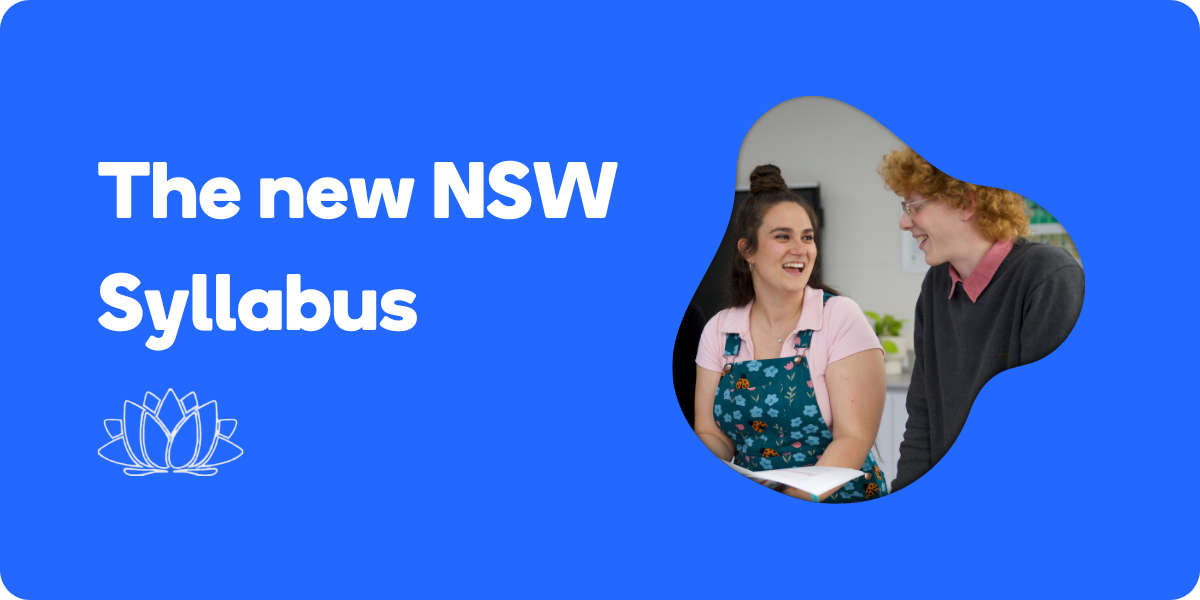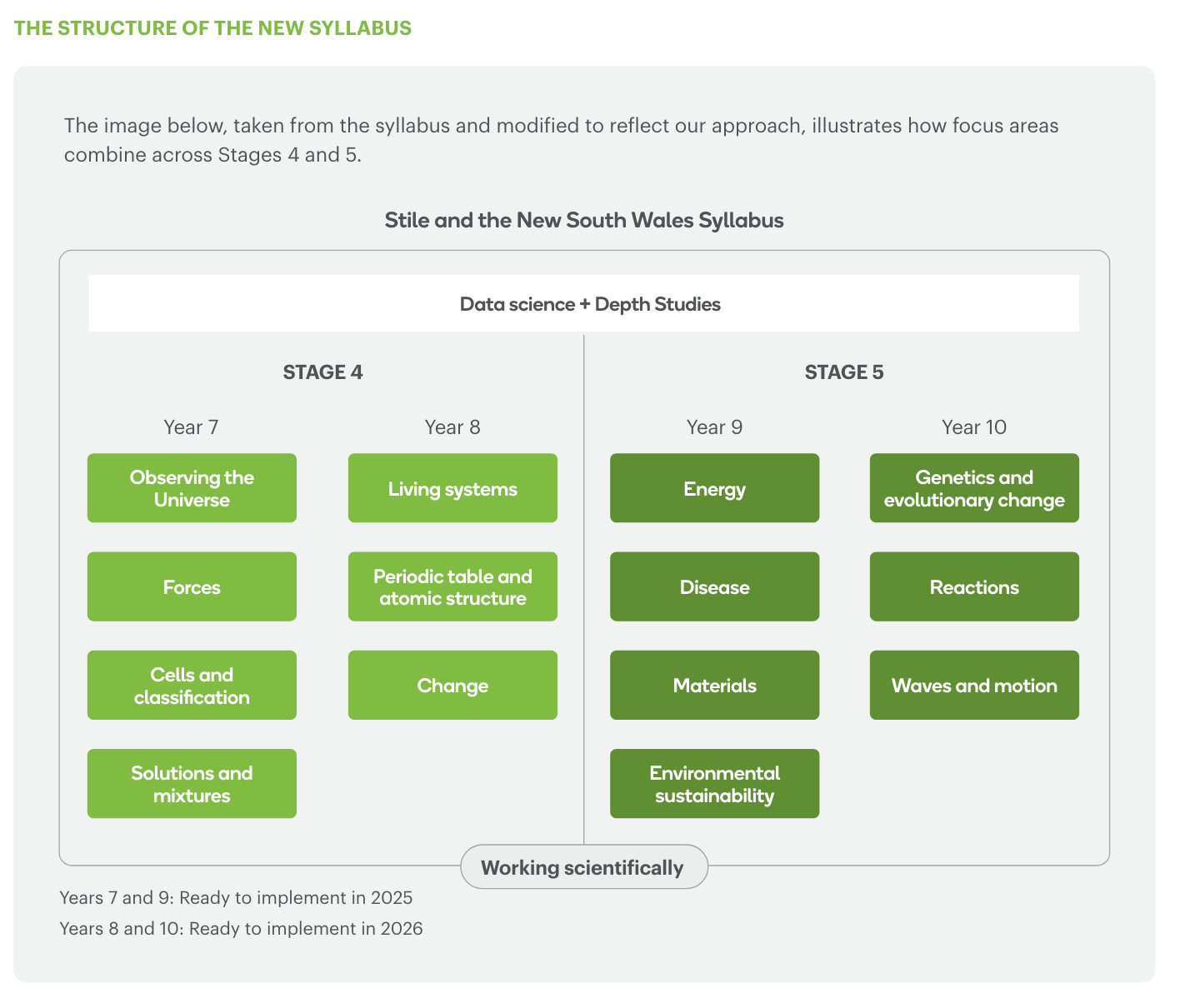The new NSW Syllabus
Stile has you covered with the new NSW Syllabus.

The release of the new Science syllabus brings an inevitable period of change, but it doesn’t have to be stressful. We’ve spent hundreds of hours analysing the new NSW Syllabus, so that you don't need to. We've created a summary of everything you need to help you understand how the syllabus has changed and how Stile is responding so you can be well-prepared ahead of time.
Read on to learn what’s different about the new syllabus and how we’ll support you in delivering a fully aligned science program before the implementation deadline.
If you’re still keen to learn more, register for our Flash PL webinar at 4pm AEST on Thursday, 30th May.
Stile has you covered
As a customisable core curriculum, our dynamic teaching platform empowers educators like you with an array of comprehensive tools and instructional and teacher support materials, including our meticulously crafted implementation guide. This powerful guide acts as a premier blueprint for tailoring your school's science curriculum while ensuring seamless alignment with the NSW syllabus.
Like all resources in Stile, we guarantee that our NSW-aligned lessons remain consistently updated and evolve in tandem with syllabus changes. Over the coming months, we’ll rework our teaching and learning resources to comprehensively cover the new syllabus. With Stile as your core resource, you’ll have an engaging, syllabus-aligned science program ready to use with Years 7 and 9 students in 2025 and with Years 8 and 10 students in time for implementation in 2026.
Our commitment extends to providing educators with everything you need, reflected in our diverse range of lessons encompassing practical investigations, depth studies, and a strong emphasis on data science – all of which are requirements of the new syllabus.
What’s changed?
We’ve identified five key changes to the syllabus:
- The introduction of focus areas
- An emphasis on data science
- The introduction of depth studies
- Integrating Aboriginal and Torres Strait Islander Peoples’ Cultural and Scientific Ways of Knowing, Being and Doing
- Content changes
1. The introduction of focus areas
Rather than being organised by strand (Physical World, Earth and Spece, Living World and Chemical World), the new syllabus groups content into focus areas. A focus area represents a theme or idea, such as “Change” or “Living systems”. Within each focus area are a number of outcomes that specify the knowledge, understanding, and skills to be learned. These include working scientifically outcomes.
Focus areas are organised into year levels across Years 7–10, as shown in the image below.

In Stile, the content for each focus area will be addressed by a number of Stile units in combination. This provides varied, rich, real-world contexts for science learning.
2. An emphasis on data science
The new syllabus emphasises data science, identifying it as its own focus area in both stages. This implies that data science alone should be taught for a full term at both Stages 4 and 5.
“SC4-DA1-01: Explains how data is used by scientists to model and predict scientific phenomena”
“SC5-DA2-01: Assesses the use of scientific knowledge and data in evidence-based decisions and when verifying the legitimacy of claims”
We believe the best way for students to learn data science is by engaging with real-world data in relevant contexts. For this reason, in alignment with updated guidance from the syllabus quoted below, we’ll continue to scaffold the development of data science across the Stile collection from years 7–10, rather than treating it as a separate focus area.
“The Data science focus area can be taught alongside other focus areas, or aligned to students’ interests, local context or school environment.”
3. The introduction of depth studies
Previously known as Student Research Projects, a depth study is “any type of scientific investigation that provides students with an opportunity to pursue their interests and deepen their scientific understanding of one or more focus areas."
A summary of the differences between Student Research Projects and Depth Studies is shown below.
4. Integrating Aboriginal and Torres Strait Islander Peoples’ Cultural and Scientific Ways of Knowing, Being and Doing
The rationale statement of the science syllabus includes a new section about Aboriginal and Torres Strait Islander Peoples’ Cultural and Scientific Ways of Knowing, Being and Doing.
“As the oldest living continuous Cultures in the world, Aboriginal and Torres Strait Islander Peoples have developed their Cultural Knowledges over millennia. These Knowledges are not static and continue to develop. Through the study of science, students have the opportunity to develop their knowledge and understanding of Aboriginal and Torres Strait Islander Peoples’ Cultural and Scientific Ways of Knowing, Being and Doing.”
Ten of the sixteen focus areas include content statements that directly address this, such as: “Identify examples of Aboriginal and Torres Strait Islander Peoples’ application of Knowledge about forces” within the Forces focus area.
In 2023, we undertook our first collaboration with First Nations educators, scientists and illustrators to develop our updated Forces unit. Read all about our commitment to incorporating Aboriginal and Torres Strait Islander Peoples’ Cultural and Scientific Ways of Knowing, Being and Doing here.
5. Content changes
We’ve done a thorough analysis of the changes to content within the syllabus in our implementation guide. Some of the key differences are described below.
- Working scientifically processes have been integrated into focus areas
- Content statements demonstrate an emphasis on investigation, developing written texts and Aboriginal and Torres Strait Islander Peoples’ Cultural and Scientific Ways of Knowing, Being and Doing
- Atomic structure, plate tectonics and ecosystems have been brought down to Stage 4 from Stage 5
- Organic chemistry content has been added to Stage 5
- An emphasis on climate change has been added, and relevant content included in Stage 5
- Observing has been added as a new working scientifically process
- Processing and analysing data and information has been divided into two working scientifically processes: processing data and information and analysing data and information
Support for implementation
We develop high-quality resources and teacher support materials so that you can focus on doing what you do best: teaching. Everything you need to teach a fully aligned science program is provided, giving you a head start on implementation.
A full suite of teacher resources
We provide a full scope and sequence to reassure you that everything is covered. By following the Stile Scope and Sequence, you’ll be addressing all of the content in the new syllabus. You’ll also find a link to an editable version, which you can customise to suit your context.
Every unit comes with:
- A comprehensive Teaching Plan outlining everything you need to know before you start teaching. Read more about what’s included here.
- A detailed illustrated Lab Guide with clear guidance for all hands-on, practical, engineering and investigation tasks.
- A parent email template to communicate with families about what students are learning and how they can engage with the topic at home.

